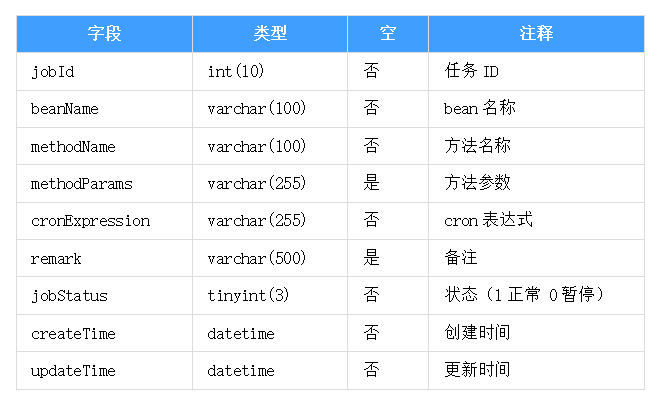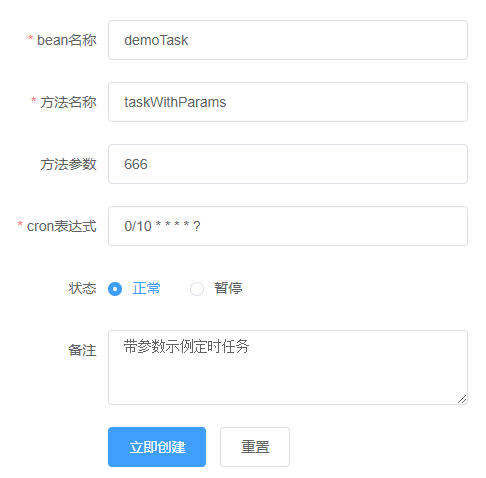我以为动态停启定时任务一般用quartz,没想到还可以通过ScheduledTaskRegistrar来拓展。但是分布式场景,建议还是用quartz吧!
在 spring boot 项目中,可以通过 @EnableScheduling 注解和 @Scheduled 注解实现定时任务,也可以通过 SchedulingConfigurer 接口来实现定时任务。但是这两种方式不能动态添加、删除、启动、停止任务。要实现动态增删启停定时任务功能,比较广泛的做法是集成 Quartz 框架。
但是本人的开发原则是:在满足项目需求的情况下,尽量少的依赖其它框架,避免项目过于臃肿和复杂。查看 spring-context 这个 jar 包中 org.springframework.scheduling.ScheduledTaskRegistrar 这个类的源代码,发现可以通过改造这个类就能实现动态增删启停定时任务功能。
定时任务列表页
定时任务执行日志
添加执行定时任务的线程池配置类
@Configurationpublic class SchedulingConfig {@Beanpublic TaskScheduler taskScheduler() {ThreadPoolTaskScheduler taskScheduler = new ThreadPoolTaskScheduler();taskScheduler.setPoolSize(4);taskScheduler.setRemoveOnCancelPolicy(true);taskScheduler.setThreadNamePrefix("TaskSchedulerThreadPool-");return taskScheduler;}}
添加 ScheduledFuture 的包装类。ScheduledFuture 是 ScheduledExecutorService 定时任务线程池的执行结果。
public final class ScheduledTask {volatile ScheduledFuture<?> future;public void cancel() {ScheduledFuture<?> future = this.future;if (future != null) {future.cancel(true);}}}
添加 Runnable 接口实现类,被定时任务线程池调用,用来执行指定 bean 里面的方法。
public class SchedulingRunnable implements Runnable {private static final Logger logger = LoggerFactory.getLogger(SchedulingRunnable.class);private String beanName;private String methodName;private String params;public SchedulingRunnable(String beanName, String methodName) {this(beanName, methodName, null);}public SchedulingRunnable(String beanName, String methodName, String params) {this.beanName = beanName;this.methodName = methodName;this.params = params;}@Overridepublic void run() {logger.info("定时任务开始执行 - bean:{},方法:{},参数:{}", beanName, methodName, params);long startTime = System.currentTimeMillis();try {Object target = SpringContextUtils.getBean(beanName);Method method = null;if (StringUtils.isNotEmpty(params)) {method = target.getClass().getDeclaredMethod(methodName, String.class);} else {method = target.getClass().getDeclaredMethod(methodName);}ReflectionUtils.makeAccessible(method);if (StringUtils.isNotEmpty(params)) {method.invoke(target, params);} else {method.invoke(target);}} catch (Exception ex) {logger.error(String.format("定时任务执行异常 - bean:%s,方法:%s,参数:%s ", beanName, methodName, params), ex);}long times = System.currentTimeMillis() - startTime;logger.info("定时任务执行结束 - bean:{},方法:{},参数:{},耗时:{} 毫秒", beanName, methodName, params, times);}@Overridepublic boolean equals(Object o) {if (this == o) return true;if (o == null || getClass() != o.getClass()) return false;SchedulingRunnable that = (SchedulingRunnable) o;if (params == null) {return beanName.equals(that.beanName) &&methodName.equals(that.methodName) &&that.params == null;}return beanName.equals(that.beanName) &&methodName.equals(that.methodName) &¶ms.equals(that.params);}@Overridepublic int hashCode() {if (params == null) {return Objects.hash(beanName, methodName);}return Objects.hash(beanName, methodName, params);}}
添加定时任务注册类,用来增加、删除定时任务。
@Componentpublic class CronTaskRegistrar implements DisposableBean {private final Map<Runnable, ScheduledTask> scheduledTasks = new ConcurrentHashMap<>(16);@Autowiredprivate TaskScheduler taskScheduler;public TaskScheduler getScheduler() {return this.taskScheduler;}public void addCronTask(Runnable task, String cronExpression) {addCronTask(new CronTask(task, cronExpression));}public void addCronTask(CronTask cronTask) {if (cronTask != null) {Runnable task = cronTask.getRunnable();if (this.scheduledTasks.containsKey(task)) {removeCronTask(task);}this.scheduledTasks.put(task, scheduleCronTask(cronTask));}}public void removeCronTask(Runnable task) {ScheduledTask scheduledTask = this.scheduledTasks.remove(task);if (scheduledTask != null)scheduledTask.cancel();}public ScheduledTask scheduleCronTask(CronTask cronTask) {ScheduledTask scheduledTask = new ScheduledTask();scheduledTask.future = this.taskScheduler.schedule(cronTask.getRunnable(), cronTask.getTrigger());return scheduledTask;}@Overridepublic void destroy() {for (ScheduledTask task : this.scheduledTasks.values()) {task.cancel();}this.scheduledTasks.clear();}}
添加定时任务示例类
@Component("demoTask")public class DemoTask {public void taskWithParams(String params) {System.out.println("执行有参示例任务:" + params);}public void taskNoParams() {System.out.println("执行无参示例任务");}}
定时任务数据库表设计
定时任务数据库表设计
添加定时任务实体类
public class SysJobPO {private Integer jobId;private String beanName;private String methodName;private String methodParams;private String cronExpression;private Integer jobStatus;private String remark;private Date createTime;private Date updateTime;public Integer getJobId() {return jobId;}public void setJobId(Integer jobId) {this.jobId = jobId;}public String getBeanName() {return beanName;}public void setBeanName(String beanName) {this.beanName = beanName;}public String getMethodName() {return methodName;}public void setMethodName(String methodName) {this.methodName = methodName;}public String getMethodParams() {return methodParams;}public void setMethodParams(String methodParams) {this.methodParams = methodParams;}public String getCronExpression() {return cronExpression;}public void setCronExpression(String cronExpression) {this.cronExpression = cronExpression;}public Integer getJobStatus() {return jobStatus;}public void setJobStatus(Integer jobStatus) {this.jobStatus = jobStatus;}public String getRemark() {return remark;}public void setRemark(String remark) {this.remark = remark;}public Date getCreateTime() {return createTime;}public void setCreateTime(Date createTime) {this.createTime = createTime;}public Date getUpdateTime() {return updateTime;}public void setUpdateTime(Date updateTime) {this.updateTime = updateTime;}}
新增定时任务
新增定时任务
boolean success = sysJobRepository.addSysJob(sysJob);if (!success)return OperationResUtils.fail("新增失败");else {if (sysJob.getJobStatus().equals(SysJobStatus.NORMAL.ordinal())) {SchedulingRunnable task = new SchedulingRunnable(sysJob.getBeanName(), sysJob.getMethodName(), sysJob.getMethodParams());cronTaskRegistrar.addCronTask(task, sysJob.getCronExpression());}}return OperationResUtils.success();
修改定时任务,先移除原来的任务,再启动新任务
boolean success = sysJobRepository.editSysJob(sysJob);if (!success)return OperationResUtils.fail("编辑失败");else {if (existedSysJob.getJobStatus().equals(SysJobStatus.NORMAL.ordinal())) {SchedulingRunnable task = new SchedulingRunnable(existedSysJob.getBeanName(), existedSysJob.getMethodName(), existedSysJob.getMethodParams());cronTaskRegistrar.removeCronTask(task);}if (sysJob.getJobStatus().equals(SysJobStatus.NORMAL.ordinal())) {SchedulingRunnable task = new SchedulingRunnable(sysJob.getBeanName(), sysJob.getMethodName(), sysJob.getMethodParams());cronTaskRegistrar.addCronTask(task, sysJob.getCronExpression());}}return OperationResUtils.success();
删除定时任务
boolean success = sysJobRepository.deleteSysJobById(req.getJobId());if (!success)return OperationResUtils.fail("删除失败");else{if (existedSysJob.getJobStatus().equals(SysJobStatus.NORMAL.ordinal())) {SchedulingRunnable task = new SchedulingRunnable(existedSysJob.getBeanName(), existedSysJob.getMethodName(), existedSysJob.getMethodParams());cronTaskRegistrar.removeCronTask(task);}}return OperationResUtils.success();
定时任务启动 / 停止状态切换
if (existedSysJob.getJobStatus().equals(SysJobStatus.NORMAL.ordinal())) {SchedulingRunnable task = new SchedulingRunnable(existedSysJob.getBeanName(), existedSysJob.getMethodName(), existedSysJob.getMethodParams());cronTaskRegistrar.addCronTask(task, existedSysJob.getCronExpression());} else {SchedulingRunnable task = new SchedulingRunnable(existedSysJob.getBeanName(), existedSysJob.getMethodName(), existedSysJob.getMethodParams());cronTaskRegistrar.removeCronTask(task);}
添加实现了 CommandLineRunner 接口的 SysJobRunner 类,当 spring boot 项目启动完成后,加载数据库里状态为正常的定时任务。
@Servicepublic class SysJobRunner implements CommandLineRunner {private static final Logger logger = LoggerFactory.getLogger(SysJobRunner.class);@Autowiredprivate ISysJobRepository sysJobRepository;@Autowiredprivate CronTaskRegistrar cronTaskRegistrar;@Overridepublic void run(String... args) {List<SysJobPO> jobList = sysJobRepository.getSysJobListByStatus(SysJobStatus.NORMAL.ordinal());if (CollectionUtils.isNotEmpty(jobList)) {for (SysJobPO job : jobList) {SchedulingRunnable task = new SchedulingRunnable(job.getBeanName(), job.getMethodName(), job.getMethodParams());cronTaskRegistrar.addCronTask(task, job.getCronExpression());}logger.info("定时任务已加载完毕...");}}}
工具类 SpringContextUtils,用来从 spring 容器里获取 bean
@Componentpublic class SpringContextUtils implements ApplicationContextAware {private static ApplicationContext applicationContext;@Overridepublic void setApplicationContext(ApplicationContext applicationContext)throws BeansException {SpringContextUtils.applicationContext = applicationContext;}public static Object getBean(String name) {return applicationContext.getBean(name);}public static <T> T getBean(Class<T> requiredType) {return applicationContext.getBean(requiredType);}public static <T> T getBean(String name, Class<T> requiredType) {return applicationContext.getBean(name, requiredType);}public static boolean containsBean(String name) {return applicationContext.containsBean(name);}public static boolean isSingleton(String name) {return applicationContext.isSingleton(name);}public static Class<? extends Object> getType(String name) {return applicationContext.getType(name);}}

